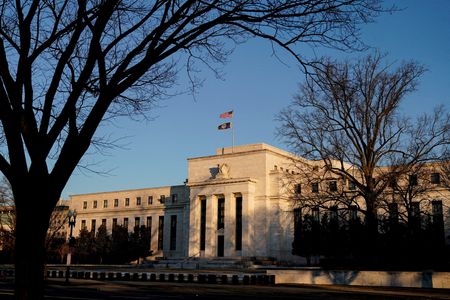By Michael S. Derby
(Reuters) – Lending officers at major banks told the Federal Reserve that in the final three months of last year they tightened standards and saw reduced demand across a wide array of business and consumer credit fronts.
The Fed reported Monday in its January Senior Loan Officer Opinion Survey that the threshold to get credit rose for commercial and industrial firms, as well as commercial real estate borrowers. At the same time, these prospective borrowers reduced their demand for loans.
On the consumer front, survey respondents said that real estate and related lending standards got tighter amid declining demand for the same period. The same dynamic played out for auto, credit card and other types of consumer lending.
The survey also found that the trends that played out across bank lending in roughly the final quarter of 2022 will dominate 2023. “Banks, on balance, reported expecting lending standards to tighten, demand to weaken, and loan quality to deteriorate across all loan types.”
The prospect of weaker loan demand is driven by changes in monetary policy and the need to navigate an uncertain economy.
The most common reasons for the expected state of lending this year “included an expected increase in interest rates, expected lower spending or investment needs, an expected deterioration in terms other than interest rates, an expected easing in supply chain disruptions, and an expected decrease in precautionary demand for cash and liquidity,” the report said.
The latest data points to a softening economy. “There were unfavorable changes across many details” of the survey, said Daniel Silver, an analyst at J.P. Morgan, who added the data “looks consistent with an economy that is weakening.”
The Fed’s report took stock of lending during a period where the Fed was pressing forward with aggressive rate rises aimed at lowering high levels of inflation. Those rate increases took the central bank’s rate target from near zero levels as of last March to between 4.5% and 4.75% after the rate hike at last week’s Federal Open Market Committee meeting.
The pace of Fed rate rises has been very aggressive and officials have said that as part of their bid to cool overheating levels of demand, tighter financial conditions are a key part of the process.
“It is important that overall financial conditions continue to reflect the policy restraint that we’re putting in place in order to bring inflation down to 2%,” Fed Chair Jerome Powell said after the Fed’s 25 basis point rate hike last Wednesday. “Financial conditions have tightened very significantly over the past year,” Powell said.
That said, as the Fed has approached the likely endgame for its rate hike cycle, financial conditions have grown a touch easier. Some believe this could make the Fed more aggressive with rate hikes in the longer run, as it needs financial conditions to stay tight as part of its bid to lower price pressures. Goldman Sachs said Monday closely watched Financial Conditions Index eased by 2.0 basis points to 99.57 in the last week due to rising stock prices that offset a higher dollar.
Research released Monday by the San Francisco Fed warned that financial conditions, as measured by lower stock prices and higher bond yields, may need to tighten even further to achieve the Fed’s aims.
(Reporting by Michael S. Derby; Editing by Mark Porter and Caitlin Webber)

